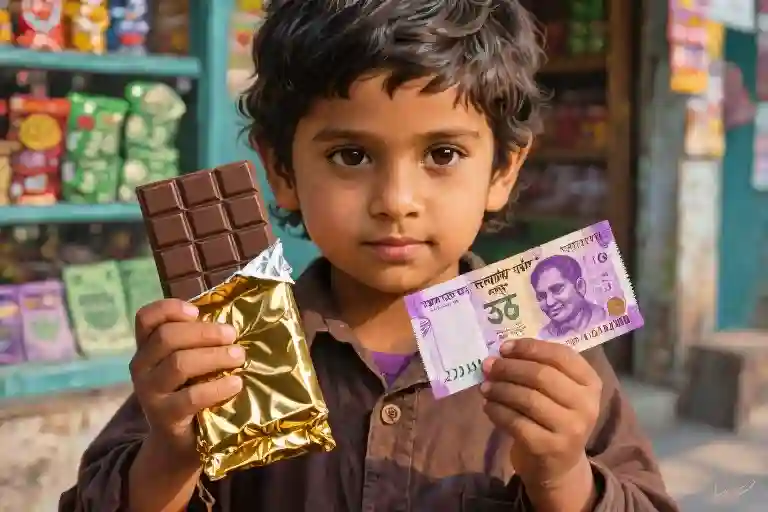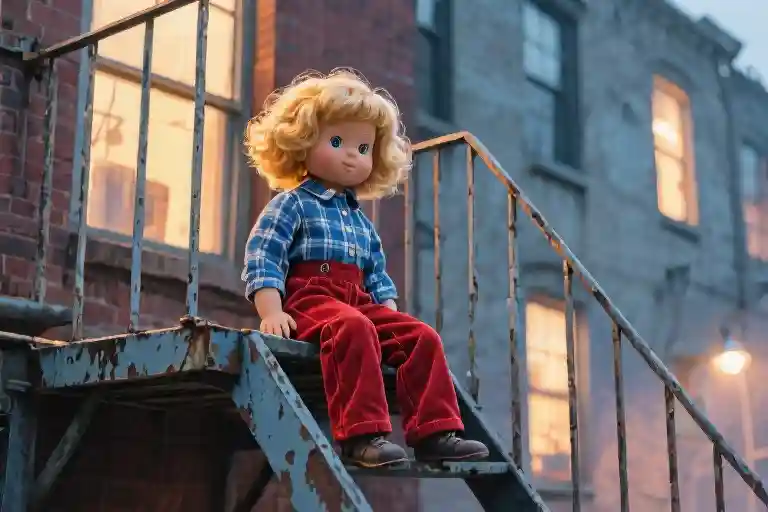The crisp hundred-rupee note felt enormous in my six-year-old palm that afternoon in 2002. In our small Indian town, that amount could buy ten chocolate bars or five comic books—a fortune by childhood standards. I remember tracing the raised ink of Gandhi’s portrait with my thumb, the paper scent mixing with shop dust and the metallic tang of coins in grandmother’s purse.
Our corner store smelled of jaggery and newsprint. Sunlight through the grimy windows made the candy display shimmer like treasure. I pressed my nose against the glass, deliberating between Cadbury’s purple wrapper and Nestlé’s red like a jeweler comparing gemstones. The shopkeeper chuckled as I changed my mind three times before sliding a Dairy Milk across the counter.
‘Ten rupees,’ he said, peeling my damp bill from sticky fingers. When grandmother nodded at the remaining ninety, I instinctively clenched them tighter. ‘For something better,’ I declared, suddenly aware of money’s alchemy—how it could transform from chocolate today to unknown wonders tomorrow.
Her frown lines deepened. ‘The sweetest things turn bitter when you’re always reaching for the next.’ At that moment, I didn’t understand how a child’s simple thrift could disappoint. The chocolate melted creamy on my tongue during our walk home, but her words left an aftertaste that lingered for decades.
What grandmother called greed, I now recognize as the first flutter of financial agency. That ninety rupees eventually bought a rubber ball that split after two weeks, yet the memory still bounces between two truths: her wisdom about presence, and my instinct that delayed gratification isn’t ingratitude—it’s faith in better possibilities.
The Jewelry Store of Candy
The corner shop smelled of damp cardboard and caramelized sugar, a scent that still surfaces in my dreams. Flickering fluorescent lights reflected off the glass countertop where rows of chocolate bars stood at attention like soldiers in foil uniforms. To my six-year-old eyes, that display might as well have been Tiffany’s—each treat meticulously arranged behind the smudged glass, their wrappers catching the afternoon light in kaleidoscopic bursts.
My fingers left sweaty prints on the counter as I pressed my nose against it, practicing the careful scrutiny I’d seen jewelers employ in my grandmother’s favorite soap operas. The Cadbury Dairy Milk bars gleamed like gold ingots, their purple packaging radiating regal authority. Nearby, KitKats stood in crisp red rows, their segmented promise of multiple treats in one purchase triggering a minor existential crisis. Would breaking them apart count as eating one chocolate or four?
Three times I circled the display, my bare feet sticking slightly to the perpetually sticky floor tiles. The hundred-rupee note in my fist had grown damp with nervous excitement—enough to buy every sweet in sight, yet somehow not enough to quiet the fear of choosing wrong. This was 2002 India, when a child could still feel like royalty with a single bill in hand.
Eventually, my fingertips gravitated toward a solitary Mars bar, its caramel swirl visible through a small tear in the wrapper. Something about its imperfect presentation made it seem more attainable than the pristine Dairy Milk bars. The shopkeeper, a man with salt-and-pepper eyebrows that danced when he spoke, rang it up with theatrical solemnity. ‘Ten rupees,’ he announced, as if bestowing a sacred truth.
When he placed the change in my palm—nine crisp ten-rupee notes—their edges felt sharper than the chocolate’s rounded corners. I folded them carefully into my pocket, already imagining the rubber ball or plastic toy they might become. The Mars bar’s foil crinkled in protest as I tore it open, its sweet aroma blooming instantly. That first bite was a revelation: sticky caramel clinging to my molars, chocolate coating my tongue like liquid velvet.
Yet even as the sugar hit my bloodstream, part of me remained acutely aware of the remaining ninety rupees pressing against my thigh through the thin cotton of my shorts. The chocolate tasted divine, but the knowledge that I’d only spent a tenth of my newfound wealth made each chew feel like a test I hadn’t studied for. Behind the candy counter, the shopkeeper’s wall clock ticked loudly, counting down the seconds until I’d have to face my grandmother’s inevitable question about the change.
The Frown That Lingered
My grandmother’s question hung in the humid air between us, heavier than the crumpled rupee notes in my damp palm. “What are you going to do with that?” she asked, nodding at the remaining ninety rupees. The shopkeeper’s ceiling fan sliced through the silence as I considered my answer.
“Save it,” I declared, puffing out my six-year-old chest. “For something better.” The words tasted grown-up in my mouth, like the bitter coffee adults drank at weddings. I expected praise for my prudence.
Instead, her eyebrows knitted together—a stitch of disapproval I’d come to recognize over years of shared meals and scoldings. “That chocolate won’t taste as sweet if you’re already thinking about what comes next.” She said it quietly, the way people mention death at happy gatherings.
In that moment, the candy shop’s fluorescent lights seemed to dim. My fingers tightened around the chocolate bar’s wrapper, its crinkling sound suddenly accusatory. Was I being greedy? The question settled in my stomach like undigested food.
Children understand moral judgments before they understand morals. I knew nothing of delayed gratification or financial planning, but I recognized the shadow that crossed my grandmother’s face—it was the same look she gave when cousins fought over festival sweets or when I pretended to brush my teeth. Disappointment, diluted with concern.
We walked home in uneven silence, my sandals slapping against pavement still warm from the afternoon sun. With each step, the chocolate in my pocket seemed to grow heavier, while the saved money felt increasingly like stolen treasure. By the time we reached our gate, I’d convinced myself the cocoa sweetness clinging to my tongue was somehow tainted.
That night, I tucked both the remaining rupees and my confusion beneath the mattress where I kept important things—a broken crayon, a marble, now this new adult worry. The lesson stuck like hot weather to skin: wanting more might mean enjoying less. For years afterward, spending money came with a phantom frown, my grandmother’s disapproval echoing in every purchase.
Only much later would I question this inherited wisdom. The chocolate had been delicious—that truth remained untouched by any saving. And the rubber toy eventually bought with those saved rupees? It brought its own fleeting joy. My grandmother’s lesson about contentment wasn’t wrong, just incomplete. Life, I’d learn, could hold both—the immediate sweetness and the patient anticipation—without diminishing either.
But on that birthday evening, lying beneath a whirring ceiling fan, all I knew was that ninety rupees felt suddenly heavy, and the aftertaste of chocolate strangely complicated.
The Delayed Rebellion
Two decades later, I finally understood what that crumpled 100-rupee note truly represented. My grandmother’s frown hadn’t been about the chocolate, nor even about the money itself. It was about that dangerous spark of possibility she saw lighting up in my eyes as I pocketed the change – the terrifying realization that her six-year-old granddaughter had glimpsed the horizon beyond the candy aisle.
Modern psychology would call it delayed gratification. Walter Mischel’s famous Stanford marshmallow experiment showed how children who resisted immediate treats often achieved greater success later in life. But those studies never accounted for the sticky-fingered joy of actually eating the marshmallow, nor the cultural weight of a grandmother’s disapproval in early 2000s India.
That remaining 90 rupees eventually bought me a squeaky rubber elephant from the same corner store. Its trunk broke within a week. The chocolate’s foil wrapper, carefully smoothed and saved in my treasure box, lasted much longer. Herein lies the paradox: the object I saved for proved fleeting, while the ‘wasted’ indulgence left enduring sensory memories – the snap of the bar breaking, the slow melt on my tongue, the way the shop’s ceiling fan made the paper currency flutter in my palm.
Perhaps the real lesson wasn’t about spending versus saving, but about understanding why we choose either path. When I interviewed developmental psychologists for a university project years later, one observation stuck with me: ‘The children who did best in follow-up studies weren’t those who never ate the marshmallow, nor those who always devoured it immediately. They were the ones who made conscious choices based on their current hunger and future goals.’
So I’ll ask you what I wish someone had asked me that day: When you hold your equivalent of 100 rupees – whether it’s time, money, or emotional energy – do you spend it fearing future scarcity or invest it expecting future returns? And might there be a third option: to simply observe which choice feels right in that moment, without judging either as moral failure?
My grandmother wasn’t wrong about the chocolate’s sweetness diminishing when paired with greed. But she missed how anticipation could be its own flavor – how saving those 90 rupees made the eventual rubber toy taste like victory, however temporary. The true failure would’ve been not savoring each experience on its own terms: the immediacy of cocoa on my tongue, the patient pride of watching my savings grow, even the childish grief when the elephant’s trunk snapped off.
Financial literacy programs today teach children to divide allowance into ‘spend’, ‘save’, and ‘give’ jars. Maybe we need a fourth jar labeled ‘savor’ – not for money, but for the awareness that some lessons outlast both chocolate and rubber. What remains isn’t whether I should have spent or saved that birthday money, but how its memory still teaches me to hold decisions lightly, like a child clutching both coins and candy, unwilling to drop either.
The Rubber Toy and the Sweetness of Memory
The remaining ninety rupees eventually bought me a rubber toy – a bright green frog that could squeak when pressed. I carried it everywhere for weeks, until its paint chipped and the squeaker grew silent. One monsoon afternoon, I left it forgotten in a rain puddle, and by evening it had dissolved into a shapeless mass. The toy was gone, but something curious happened: I didn’t miss it. Not really.
What stayed with me instead were two sensations I couldn’t shake – the crinkling sound of the chocolate wrapper between my fingers, and the way my grandmother’s eyebrows had drawn together when I announced my plans to save the money. These memories outlasted the physical objects by decades. That cheap chocolate bar’s foil wrapping left more fingerprints on my soul than any expensive gift ever could.
Psychologists call this phenomenon the ‘peak-end rule’ – we remember experiences not by their entirety, but by their most intense moments and how they concluded. My six-year-old self had accidentally conducted the perfect experiment in delayed gratification versus immediate pleasure. The rubber toy represented delayed gratification’s dirty little secret: sometimes the things we wait for don’t deliver the satisfaction we imagined. Meanwhile, that simple chocolate bar became a sensory time capsule because I’d fully immersed myself in enjoying it, despite my grandmother’s warning.
This duality shapes how I approach money and happiness even now. Financial advisors preach about compound interest and emergency funds (and they’re not wrong), but rarely discuss how denying all present joy can make future savings feel meaningless. The healthiest money mindset acknowledges both truths: saving ninety rupees taught me planning, but spending ten taught me presence. That chocolate bar’s sweetness wasn’t diminished by my awareness of the remaining money – if anything, knowing I’d already provided for tomorrow allowed me to fully savor today.
Modern research on childhood money lessons confirms this balance matters. A Cambridge University study found children form money habits by age seven, but the healthiest behaviors emerge from households that discuss both responsible saving and intentional spending. My grandmother’s generation viewed money as either spent or saved; we now understand it as a tool for crafting experiences whose value compounds in memory rather than in bank statements.
That dissolved rubber frog taught me more than any intact toy could have. Material things fade, break, get lost – but the feelings we attach to them? Those keep. Not on price tags, not in bank balances, but in the neural pathways where joy and meaning intersect. Some satisfactions can’t be deferred, because childhood – like life – expires faster than we expect. The art is in knowing when to save the rupees, and when to let chocolate melt on your tongue without guilt.
Perhaps this is what my grandmother feared most – not that I’d learn to delay gratification, but that I’d forget how to receive simple gifts from the present moment. She wasn’t entirely wrong, just incomplete. Because here’s the paradox: that chocolate tasted sweeter precisely because I knew I’d already taken care of tomorrow. True abundance isn’t choosing between now and later, but learning to hold both in your hands at once – like a child clutching both chocolate and coins, sticky fingers and all.





